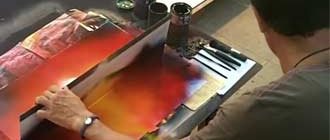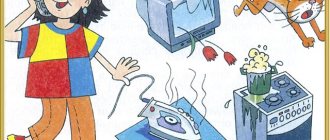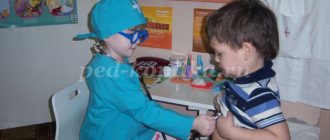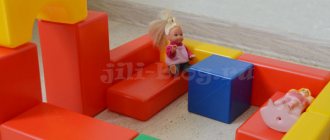The benefits of painting with paints for children
One of the popular creative options for preschoolers is fine art. Teaching a child to draw from an early age has a positive impact on the formation of his personality, helps to develop not only imagination, but also abstract thinking.
The benefits of practicing this type of creativity:
- Development of fine motor skills. Artistic activities require movements of the fingers and hand, which activates areas of the brain responsible for speech, thinking, coordination, and memory. During the drawing process, both hemispheres work, which helps strengthen the connections between them.
- Self-expression. Through drawing, the child projects his inner state onto paper. He expresses thoughts and feelings that he cannot or does not want to express. This allows you to get emotional release and lift your spirits.
- Developing the ability to identify priority goals. In the process of creativity, the child receives a result - a painting. This teaches him to set goals for himself, compare early achievements with past ones and work to improve them.
- Developing patience and perseverance. Systematic painting lessons and working on each drawing teach the child discipline and help structure time.
- Increased self-esteem. Creative activities allow a child to distinguish himself among his peers and feel important.
- Development of creativity. Drawing teaches abstract thinking and contributes to the formation of an individual view of things. Painting not only develops imagination, but also helps to find practical application for new skills.
- Understanding the world around us. Through creativity, the child learns to understand that people can perceive the same objects or phenomena differently and experience different emotions towards them. This develops empathy and social skills.
- Introduction to culture. Learning to draw develops children's taste and aesthetic perception.
- Positive impact on the psyche. Painting classes calm, pacify, and provide an opportunity to productively use accumulated energy. Art lessons are especially useful for children who are aggressive, moody or prone to depression.
In the process of learning to paint, spatial and associative thinking develops, skills of projection onto a plane and orientation in space are developed. This contributes to the mastery of other school subjects and scientific disciplines: mathematics, chemistry, physics, geography, drawing, etc.
Optimal age for skill development
It is best to start teaching children the basics of drawing from an early age - from 6 months to 3 years. During this period, the child should learn the basics, but targeted lessons are not required.
It is enough to provide everything necessary for the development of creative abilities. Games with finger paints improve fine motor skills, imagination, and creativity, which has a positive effect on the formation of not only artistic skills, but also personality.
Targeted drawing training can begin at the age of 5-7 years. During this period, the creative process becomes more meaningful, the child learns to compare and cognize, improving his skills.
Creating a painting turns from a game into a conscious action. At this age, you can begin to work with different types of paints and paper, drawing techniques. This will help you understand what the aspiring artist has the most ability and desire for.
Learning the art of drawing in a playful way.
Tips for parents
Although the benefits of drawing for children are undeniable, there is no need to insist if there is no interest in it at first. You should not neglect other games that will ensure the development of the necessary skills. Make a bull craft for the New Year, read and memorize poems for 2021, solve puzzles in pictures. Monotonous activities quickly become boring, so you should add variety to developmental activities.
Also, parents should not forget about finger games. It is useful to practice modeling from plasticine. The main advice is that there is no need to wait for masterpieces; it is much more important to encourage the baby as much as possible.
What paints are best for children's creativity?
When teaching a child to draw from scratch, it is important to choose the right paints.
The most common types used for children's creativity:
- Finger paint. Made from food coloring and water. Safe for health, easy to wash off, wash and clean from any surface. They have a thick consistency, so they stick well to your fingers and lie smoothly on paper. Suitable for babies aged 6 months and older.
- Watercolor. The most common option for beginning artists, which is most often used in kindergartens and schools. Watercolor paints are made from environmentally friendly materials, are easy to use, and have a bright and rich palette. They easily mix with water and lie on paper in translucent layers, while maintaining richness and juiciness.
- Gouache. Suitable for children aged 5-7 years. It has a dense texture and bright colors when applied to paper. The composition can be either safe or containing toxic substances. For children it is better to choose the first option.
- Oil paints. Valued for ease of use, ease of mixing, and durability of the pattern. They dry without changing color, unlike acrylic or watercolor. Made from vegetable oils. Since economical consumption is important when using such pigments, they are best chosen for children 6-7 years old who are already familiar with the basic rules of painting.
- Acrylic paints. Manufactured from synthetic components. They dry quickly, are easy to dilute and mix, and are suitable for drawing not only on paper, but also on wood or fabric. Acrylic paints are chosen for children 6-7 years old who have already mastered the basics of watercolor painting.
It is better to avoid too bright, acidic tones. Colors should be moderately saturated. The optimal set for a child 6-7 years old is 12-20 shades. Before purchasing, it is recommended to check the paints: they should be moist, uniform in texture, without a sharp, pronounced odor.
Watercolor paints.
Other tools
For painting, you will also need additional tools.
Their list:
- Brushes. It is better to buy a set of several products of different thicknesses: this will make it easier for your child to realize his creative ideas. For watercolors, choose brushes with natural squirrel or raccoon bristles, and for thicker, more saturated paints, use hard tools with artificial bristles. The holder material that is most comfortable for a child’s hand is wood.
- Paper. For drawings by a novice artist, album sheets of A4 format are suitable. When the child gets comfortable with the basics, it is recommended to replace them with special paper for certain types of paints (for example, watercolor or gouache). This way the pictures will become more juicy and beautiful.
- Palette. This is a device for mixing paints. Made from plastic. On the palette, the child can mix different colors and get new shades without damaging the paper.
- Pencil and eraser. Needed for drawing contours. It is advisable to choose a soft pencil, especially when working with water-based paints.
- Water container. Any cup, glass or jar will do. If your child spills liquid, it is better to buy a special mug with a protective lid.
For convenience, you can purchase a special tablet holder for paper or a small easel. It will teach the child to draw without rotating the sheet, which will be a good help for further artistic training.
Brushes and palette.
Developing a child's drawing talent
Having noticed a child’s craving for drawing, parents should think about developing his abilities: enroll him in an art school, in an appropriate club, or even contact a private teacher who offers individual training.
But experts recommend enrolling a preschooler in specialized institutions only if he himself enjoys attending classes. And if a child does not want to go to art school, or parents prefer to temporarily postpone education, it is quite possible to develop the talent of a preschooler independently.
What should drawings be like for children 6-7 years old and older?
In the drawings of preschoolers and children aged 6-7 years, a clear plot and design begins to be visible. The basis for it is often everyday and social situations from the child’s experience: communication with family, playing with friends at school and kindergarten, visiting a store, hospital and other public places.
Often, motifs from fairy tales or cartoons can be traced; the child depicts literary characters, animals, and familiar places. Children 6-7 years old also draw household objects: furniture, dishes, etc.
The picture of a child reflects his inner state and worldview. Child psychologists advise paying attention to the general mood of the image: it should not be aggressive or depressive.
The constant presence of such motives (sad or quarreling people, large teeth and claws in animals, etc.) may indicate psychological problems.
At 6-7 years old, children should have basic drawing skills. Clear lines with strong pressure, shading and shading that do not go beyond the contour, recognition of the objects and ideas that the artist tried to convey, testify to his correct development.
If the drawings do not meet these criteria, there may be both psychological and physical problems, such as vision problems, neurological disorders, or poor fine motor skills.
Free drawing.
How to teach a child to draw? General recommendations
Prepare your workspace and drawing tools so that it is comfortable for both you and your child, and everything you need is at hand.
You will need:
- Oilcloth - to protect furniture from paint;
- An apron for yourself and your child, so as not to spoil things.
- Album with thick paper. It is easier to draw in it and the drawing will not be imprinted on a blank sheet of paper;
- Markers;
- Wax crayons;
- Colored and plain pencils. For children under 5 years of age, choose triangular ones; they are more convenient to hold in a small hand. For older people, regular pencils are suitable;
- Paints: gouache, watercolor or finger paints.
To teach your child to draw, prepare him for the lessons. You cannot force a child to draw. This way you run the risk of developing a lifelong hatred of fine art.
Alena Nesanelis advises raising the value of classes and making them rewards for good behavior and help. For example, ask your child to put away the toys, and for this you will draw with him.
To teach drawing to young children, you must first captivate them. Come up with games, use stencils and available materials so that the process captures the child’s attention completely. Believe me, the game will captivate the baby more than cartoons.
Gaming techniques:
- Posing
Draw a sketch of a person in different poses and ask them to repeat them, and then come up with your own pose and depict it on paper.
- Fairy tale
Invite your child to illustrate their favorite fairy tale or come up with your own. Talk through the episode and draw it together. Let the little one show his imagination. Don't correct it or impose your vision of the plot.
- Cartoons
Draw figures in motion on different pages of your notebook. When viewed quickly, they will move and you will get a cartoon.
- Applications
Draw objects and glue them onto whatman paper. You can make part of the applique from dried flowers, leaves and magazine clippings.
Cut out large parts from colored paper and glue them onto a landscape sheet, ask your child to complete the drawing of hands, eyes and mouth.
- squiggle
Draw a squiggle on a blank sheet of paper. Ask your child what it is associated with and ask him to complete the drawing.
- Letter
The technique is suitable for children who know the alphabet. Ask to write the first letter of the name, and next to it depict how the child characterizes himself.
- Fears
The method helps to get rid of childhood fears through drawing. Ask your child to draw his fear. Invite him to tear it so that he is defeated.
Second option: add funny details so that it becomes not scary, but funny.
Yulia Lomakova said that often children do not want to draw because they cannot draw beautifully. Solving the problem is simple - show your child new techniques!
See how easy it is to teach your child to draw animals:
Have you tried all the methods, but still haven’t managed to teach your child to draw? Does your child show no interest in drawing and is capricious? Don't force him to draw. Perhaps he prefers to sing or dance. Allow your child to express himself through his favorite activity.
How to choose a drawing plot for preschool children
When choosing a painting theme for a child, you need to take into account 2 factors: the level of his skills and personal interests.
Popular drawing subjects for preschoolers:
- scenes from fairy tales;
- situations from the life of family and friends;
- visiting public places;
- landscapes, scenes with animals;
- the work of people of various professions - doctors, cashiers, rescuers, etc.
When choosing a plot, it is important to leave the child freedom for creativity. The topic should guide the student's imagination rather than limit it.
Fairy tales.
Palm drawings
Handprint painting is a good way to develop creative thinking in young children.
For this purpose, special paints are used that adhere well to the hand, leave a clear imprint on the paper and are safe in case of accidental ingestion.
With your palms you can draw:
- flower petals;
- branches and crowns of trees;
- other plant parts, such as carrot tops;
- fish, jellyfish and octopuses;
- animals - 4 fingers will be “paws”, and the remaining one will be the tail.
Later, various details are added to the resulting silhouettes with fingers or a brush. The child can do this either independently or with the help of his parents. Drawing with palms develops abstract thinking and helps to see different objects in one simple form.
Palms are an excellent drawing tool.
Step-by-step creation of drawings by children
The most important thing in learning any type of creativity is constant practice. Before learning to draw complex, intricate paintings, a child must gain an understanding of simple shapes and the basics of composition.
At the initial stage, learning from ready-made sketches and step-by-step instructions is best for mastering the basics.
They should not limit the imagination and desires of the young artist, but only guide.
Snowflakes and winter ornaments
The image of snowflakes develops imagination and abstract thinking well.
Procedure:
- Draw a circle. Place a dot in the center.
- Focusing on it, cross out the circle horizontally, vertically and twice diagonally - you should get 8 lines inside. This will be the base of the snowflake.
- The blank is filled with circles, lines, zigzags, polygons and other shapes, creating an individual pattern. Similar actions are performed with each beam, maintaining symmetry.
It is worth giving your child creative freedom and the opportunity to draw according to their individual skill level.
Winter motifs in drawings.
Red Apple
Images of fruits and berries are the basis of most educational programs. Using their example, the child understands the basics of lighting and darkening, and color selection.
Steps for drawing a block:
- Draw a circle. Adjust the shape of the top and bottom parts to create the silhouette of an apple. Draw a line (“dimple”) in the upper part, mark the stalk and leaf.
- Apply the first layer of watercolor. It should be light, almost transparent. The apple can be decorated in green, yellow, red colors or a combination of shades at the child’s discretion.
- Color the fruit in a basic tone, skipping areas of highlights.
- Starting from the top of the apple, apply shadows, adding specks of paint and gradually stretching them with a brush.
Having completely painted the base, they begin to draw the stalk and leaf, thicken the outline and other finishing touches.
Fruit still life.
Watermelon gouache
Drawing a watermelon is another easy way to become familiar with basic shapes in painting.
Step-by-step instruction:
- Draw a triangle. Erase one of its sides and replace it with a semicircle, and also make the opposite vertex rounded.
- Inside the resulting outline, select the peel and the layer between the peel and the pulp.
- Paint the main part of the watermelon red. Highlight the layer between the pulp and the peel in green, making a smooth transition.
- Color the peel deep green. Add some dark stripes.
Lastly, you can add a few dark brown and yellow watermelon seeds.
Drawing landscapes
Using paints, it’s easy and quick to paint landscapes - from forests and mountains to the sea or the night sky.
The specifics are different, but the technique remains the same:
- Draw a pencil sketch. It should be as simple as possible and indicate only shapes, without details.
- Paint the background with primary colors: for example, sea and sand or field and sky. Draw large objects such as plants or mountains.
- Apply shadows and highlights. Add surroundings: clouds, waves on the water, etc.
Lastly, small details are completed: seagulls in the sky against the backdrop of the sea, fruits on the trees, etc.
Landscape with colors.
Techniques for working with artistic colored pencils. Types of hatching
The publication about the peculiarities of working with artistic pencils received a great response. Many people wanted to learn more directly about the techniques of drawing with this instrument of fine art.
This publication about techniques is rather theoretical in nature, something that needs to be honed only in practice. So dare, try, break pencils and don’t be afraid of anything. Everything will work out, and it will take a lot of paper.
But believe me, it's worth it!
So, let's begin.
- Straight hatching
This technique is a classic drawing and will be used more often than others.
We sharpen the pencil so that it is very sharp. And we put strokes diagonally, pressing evenly on the pencil, with the same distance between the lines. At first, every now and then clear lines will appear in places due to the fact that you press unevenly on the pencil. The hand will not obey and the pressure will be different. But this is only the first ten minutes.
This technique requires some training. Don't be afraid if it doesn't work out right away. Try again and again. Ideally, it would be good to completely cover the A4 sheet.
Then draw a circle and stroke around it, placing strokes according to the shape.
In general, you need to hatch exactly according to the shape in order to emphasize the volume of the object. As an example, I schematically showed how the stroke lines will be positioned when drawing a blackberry leaf. Since it has additional volume between the veins, the leaf seems to bend between them.
- To obtain cross-hatching, place another layer on top of the first layer at an angle of approximately 30-45° from the first. Another name for it is caulk. Mainly used for background covering.
You can put not only two layers of strokes, but also more. The main thing is that they should be at different degrees. If you initially placed the second layer at a high degree, then place another layer of stroke at a medium degree between these two.
- Tushevka . This is drawing with the side of the stylus. The pencil must be sharpened with a knife so that the lead is long. When drawing with colored pencils, you can do shading simply with an unsharpened lead and light, even pressure, since art pencils themselves are soft. On the Internet, I met an artist from Austria who does shading with small circular movements. And it turns out very beautiful. The main thing is that the stroke lines are not visible.
Notice how I hold the pencil: at a sufficient distance from the lead. This makes it easier for them to maneuver, plus it ensures even pressure.
Shading allows you to gently apply color. It creates a “cotton” effect, especially if the paper has a texture.
Using shading is also convenient for glazing. For example, I put another layer of light yellow on top of the blue wash.
As you can see, art pencils blend beautifully on paper due to their softness. But more about the mixing technique below.
Shading can be placed on top of a straight or cross stroke for greater color saturation and density, as well as to smooth out unevenness.
- Stretching. This is a smooth transition from light to dark
Barely pressing on the pencil, gradually increase the pressure.
The important word here is gradually.
At first there may be sharp transitions and lines, but soon you will train your hand. Try stretching all the colors of a set of pencils to get an idea of what they can do.
Let's get everything out of the pencil!
What is stretching used for? Of course, the sky comes to mind. In fact, it is used almost everywhere with the addition of other techniques.
Flower petals, background, adding volume to smooth objects (porcelain, plaster, drapery, etc.).
- Changing shade . Essentially it is mixing colors on paper. Here we remember the basic rules of mixing and the color wheel:
— yellow+blue=green;
— red+blue=purple;
— red+yellow=orange.
We dance from the stove. These three rules are the stove.
Of course, you don't have three pencils in your set. Getting blue by mixing is not necessary, but nice 
Knowing and mastering these rules well, you will learn to feel color and understand what shade to add to get the desired one. Sometimes a small addition of a certain shade brings a richness of color to the work and makes it interesting. You can change the shade using not only two colors, but also more.
- Infusion of color.
Essentially, this is the same stretching, only colored. This technique is used all the time, no matter what you decide to draw.
For example, we need to make a transition from yellow to red. Let's imagine that we are drawing an autumn leaf.
First we paint with yellow, then we move to orange, then red. At the same time, we apply color to the neighboring color. Here you need to “maneuver” with pressure. When moving the orange pencil along the yellow one, the pressure should be light, then increase it.
We are trying to make the transition smooth. To do this, we use the shading we already know. Layer the strokes in layers according to the shape of the object.
This concludes our short educational excursion into the technique of drawing with colored pencils. So to speak, the theory has been obtained. You can also move on to practice.
I wish you diligence, a light hand, patience and creative impulse!
If you have any questions, don't hesitate to write in the comments.







